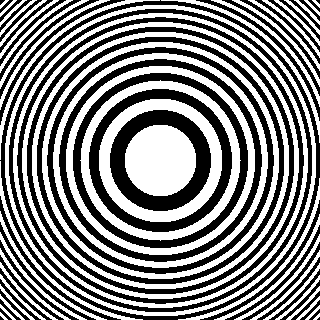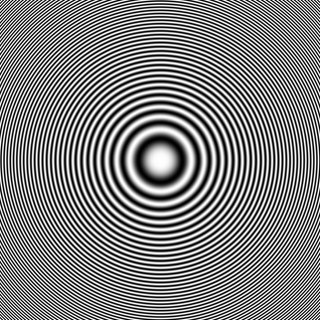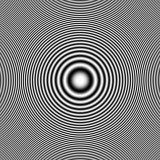
by W.A. Steer PhD
About...

 Zoneplates consisting of alternate opaque and clear, or metallic and
non-metallic concentric rings are commonly used to focus light or
microwave radiation. Similar patterns also have uses in resolution-testing
and quality-assessment of 2D imaging and filtering systems. This page
introduces the geometry and uses of zoneplates and offers a downloadable
program to construct them.
Zoneplates consisting of alternate opaque and clear, or metallic and
non-metallic concentric rings are commonly used to focus light or
microwave radiation. Similar patterns also have uses in resolution-testing
and quality-assessment of 2D imaging and filtering systems. This page
introduces the geometry and uses of zoneplates and offers a downloadable
program to construct them.
Introduction
Zoneplates made of alternating rings of absorbing/transmitting
or reflective/non-reflective materials are commonly used to focus
electromagnetic radiation, typically microwaves or visible light. In the
commonest case the concentric rings have radii proportional to the square
root of the integer series, ie. 1, sqrt(2), sqrt(3), sqrt(4)=2, ...

Two-tone zoneplate, commonly used for focussing electromagnetic radiation
Such plates also have the property that the pitch (or frequency) of
the rings increases linearly across the pattern, which gives rise to
applications in the testing or evaluation of imaging and image-processing
systems.

Greyscale zoneplate, commonly used for analysing imaging systems

| |
| Rogue rings are a typical result of undersampling in a digital imaging or
processing step | |
Software to download
Zoneplot is a simple application which runs under Windows 95 or later and
enables you to generate basic symmetrical zoneplates of arbitrary size. It
doesn't need any installation, won't touch your Windows Registry, and
doesn't need or install any special .DLLs. Simply download the .exe file
and run or "open" it.
Download: zoneplot.exe (may need Borland run-time library DLLs?)
By downloading this file, you consent to the standard disclaimer.
Details
I hope to add more details of the mathematical equations linking ring size
with focal length (and the short-focal-length 'corrections') and give more
examples of applications, as and when time permits...
Created: April 2002
Last modified: 23 November 2003
Source: http://www.techmind.org/zoneplate/
©2003 William Andrew Steer
andrew@techmind.org
![]()
![]()
 Zoneplates consisting of alternate opaque and clear, or metallic and
non-metallic concentric rings are commonly used to focus light or
microwave radiation. Similar patterns also have uses in resolution-testing
and quality-assessment of 2D imaging and filtering systems. This page
introduces the geometry and uses of zoneplates and offers a downloadable
program to construct them.
Zoneplates consisting of alternate opaque and clear, or metallic and
non-metallic concentric rings are commonly used to focus light or
microwave radiation. Similar patterns also have uses in resolution-testing
and quality-assessment of 2D imaging and filtering systems. This page
introduces the geometry and uses of zoneplates and offers a downloadable
program to construct them.


